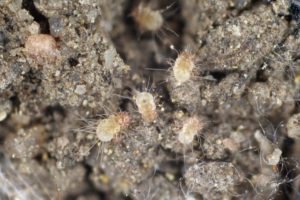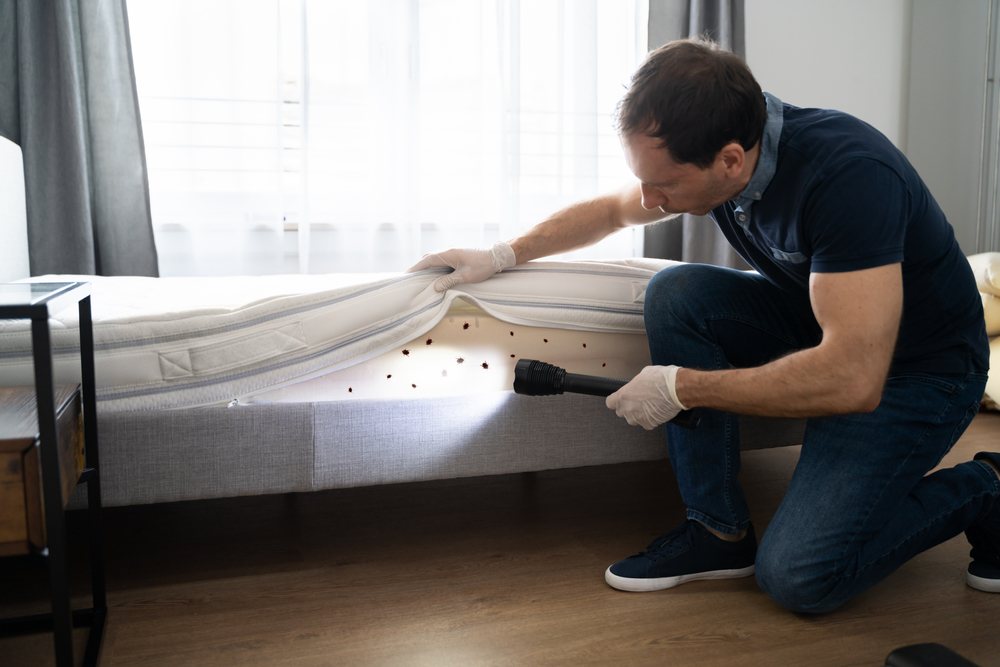Both bed bugs and dust mites are small pests that can potentially cause a lot of harm to your household…
Depending on how quickly you discover an infestation.
Knowing the difference between these two insects can help you more quickly identify these pests if they find their way into your home.
Quick identification is key to solving this time-sensitive pest problem.
Page Contents:
Dust Mite Bites vs. Bed Bug Bites
Bed bug bites are easily identifiable if you know what you’re looking for.
Because bed bugs crawl on your skin when they leave bites, you will usually notice that the bites follow a pattern that resembles a straight line or zig-zag.
This pattern is a tell-tale sign of bed bugs.
On the other hand, dust mites don’t usually leave bites, instead, they can cause a topical allergic reaction.
This reaction manifests as an irritating skin rash. This type of skin rash caused by dust mites is red and itchy.
Some people are more allergic to dust mites than others, and they can cause other typical allergy symptoms like sneezing, coughing, and itchy eyes and throat.
What do Dust Mites Look Like?
Dust mites are extremely small creatures, about 0.3mm in length. They are also translucent in color.
This means that, to the naked eye, they are very difficult to see. They are easier to spot on darker-colored surfaces than light.

If you happen to get a look at one close-up, you’ll see that they have fat, roundish bodies and 8 short legs.
What Do Bed Bugs Look Like?
Comparatively, bed bug sizes range between 1 to 7mm, significantly larger than dust mites. They are much more noticeable than dust mites at a glance.
Bed bugs are oval-shaped with 6 legs and a segmented body. Rather than being completely translucent, they have a reddish-brown color.
This color can cause them to blend in with dark or similarly colored surfaces, but they are very visible on white or other light surfaces.
Is it Easy to Mix Up Dust Mites & Bed Bugs?
If you don’t know what to look for, it can be easy to mix up these two pests.
They tend to enjoy a similar habitat, climate, and diet, so you can find them in the same places around your home if you think you’re experiencing a pest infestation.
Both bed bugs and dust mites live in climates that are warm and humid because they draw in water from the air instead of drinking it orally.
While bed bugs feed on blood (hence the bites), dust mites eat dead skin cells.
Because these cells usually fall off us, dust mites don’t have as much incentive to physically crawl onto a living host to feed.
Rather, they like to remain in places where skin cells tend to collect, like fabrics and plush surfaces in the home. Coincidentally, bed bugs hang out here as well, but they’re waiting for an unsuspecting host to arrive.
Places, where both dust mites and bed bugs can be found, include:
- Furniture
- Curtains
- Carpet
- Blankets and pillows
- Mattresses
- Rugs
- Plush toys
Or any other surfaces that allow for good hiding spots!
What Are the Signs of Dust Mites?
With bed bugs, you are more likely to notice these insects present in your home because of the physical symptoms you’re experiencing.
With dust mites, this is also true. You’re likely to notice allergy symptoms before you actually see any physical insects around your home.

Dust mites do leave behind feces, but it is very small and can only be seen with the help of a microscope.
The other major difference between dust mites and bed bugs is their prevalence. In the United States, it is estimated that 1 in 5 households either have personally experienced bed bugs or know someone that experienced an infestation in their lifetime.
In contrast, experts estimate that about 75% of American households have dust mites at any given time. Given that, the issue at hand is not whether you have dust mites in your home, but how bad the infestation is.
A small number of dust mites in the home won’t cause any allergy symptoms and will be unnoticeable due to their small presence. As long as no one in the home is severely allergic, dust mites won’t even introduce themselves as an issue.
When household members begin experiencing otherwise unexplained allergy symptoms, that may be an indication that the dust mite population in your home needs to be controlled.
How to Get Rid of Dust Mites
While it is rather difficult to completely exterminate an existing dust mite population, it is fortunately not too hard to significantly reduce it.
Traditional home cleaning methods can remove dust mites from your home as well as their food source. Washing any plush or fabric items will flush them away, and wiping dust from other surfaces is also very effective.
It’s important to catch dust and dispose of it rather than brush it from your home surfaces since the dust mites will simply move to wherever the dust has landed.
This means using a wipe or mop rather than a feather duster or similar tool.

Vacuuming your carpet, rugs, and other hard-to-reach areas are effective techniques as well.
By practicing these methods frequently, you can fairly easily get rid of dust mites and prevent them from spreading throughout your home.




